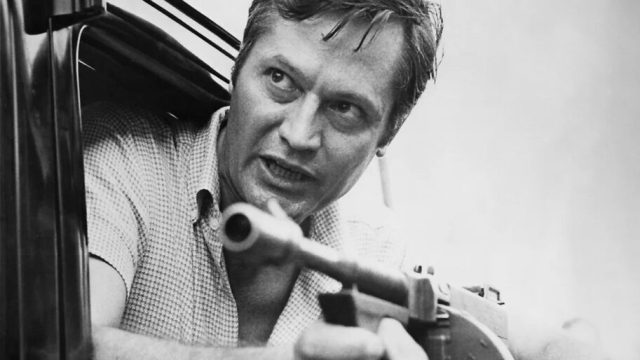This week, learn about:
- B picture royalty
- new horror
- music biopic trickery
Thanks to Nunya for contributing this week, may Vincent Price haunt your castle sets. Send articles throughout the next week to ploughmanplods [at] gmail, post articles from the past week below for discussion, and Have a Happy Friday!
A double feature on the recently departed and massively influential Roger Corman! For the RogerEbert site, Matt Zoller Seitz talks of the long legacy of filmmakers given their first break by Corman:
Anyway, back to Amy Holden Jones: Spielberg wanted her to edit “E.T. the Extraterrestrial” but when production was delayed by Spielberg producing “Poltergeist” first, she turned it down and went to Corman and asked what she needed to do to become a director. Corman said it was difficult to tell from her only existing work as a filmmaker, a nonfiction short she’d done in grad school, that she could handle scripted features, but he let her go through his library of un-produced screenplays to find something she could use to make a proof-of-concept test piece. She chose a horror script by Rita Mae Brown and shot the first eight pages with her husband Chapman serving as cinematographer, edited it on Joe Dante’s Moviola, and showed it to Corman, who was so impressed that he hired her to expand it into a feature, 1982’s “The Slumber Party Massacre.” Jones has said that turning down the chance to edit what became the most successful movie of all time was the best decision she ever made.
And at The Reveal, Scott Tobias talks about a Joe Dante/Allan Arkush satire of the Corman machine:
Hollywood Boulevard began life as a bet between Corman and its producer, Jon Davison, whose future credits would include another spoof, Airplane!, four years later and Paul Verhoeven’s RoboCop and Starship Troopers. Davison wagered that he could make the cheapest film in New World Pictures and he was true to his word: Hollywood Boulevard was shot in 10 days on a $54,000 budget, using the short ends of raw stock from other films and generous amounts of footage from other New World productions. But such built-in liabilities were assets for Dante and Arkush, who seize the opportunity to roast Corman for just this sort of fly-by-night operation. The cheaper and more patched-together the film looks, the greater the comic verisimilitude. More money would have added detrimental polish. Dante had cut trailers for Corman and knew how to slap something together.
ReverseShot‘s Juan Barquin interviews Jane Schoenbrun on the origins, aesthetics, and “egg crack” of I Saw the TV Glow:
I think that aesthetically the films are not as far apart as the internet-television dichotomy might suggest. I would have actually loved to shoot the third-person camera stuff in World’s Fair on 35mm or 16mm, probably the latter. We shot it on digital in Super 16 mode, which is supposed to mimic the look of film, but it kind of just doesn’t. It gave the film a kind of softness that I appreciate, but it really was explicitly the intention with World’s Fair that the camera is speaking in a “cinematic language” and lo-fi stuff is all about the haze of “found-media.” TV Glow is ultimately doing a similar thing, even though it’s VHS and an analog haze instead of early-internet lo-fi, or Photobooth on the Mac, haze. The interest is similar, but in terms of formal experimentation, I think it just comes quite naturally. I don’t know that I’m even necessarily experimenting, because I’m not ready to do all the things that aren’t experimentation—including coming up with the story, and characters, and a production plan—until I’ve found a structure. And that’s not just a narrative structure but a formal structure, like the language on this film is incredibly important to me. The guiding ideas, aesthetically and thematically, of the movie have to inform all the other things, or else I’m just making it up as I go along and that doesn’t feel good.
On the occasion of Amy Winehouse biopic Back to Black, Anna McKibbin muses on whether to re-record or to lip-sync famous artists on screen at Crooked Marquee:
In theory the presence of a different and distinct musical voice would offer audiences something new to grasp onto, a thrilling new take on the songs (and songwriting) they love. But rather than retroactively justifying the existence of the biopic, the technique often serves to remind us of the form’s limits. In Taylor-Johnson’s attempts to distance listeners from the source, it leads them back to purity of Amy’s original renditions. Abela mimics the cues that had cemented Winehouse in the culture, but the result is a sonic uncanny valley, familiar but a few steps removed from the artistic moment concocted in real time.
Polygon‘s Tash Robinson on why she’ll watch the new Max documentary on MoviePass:
I don’t need to watch MoviePass, MovieCrash for a summary of all this — I lived it, and not that long ago. What I want is to see the people behind the debacle. Throughout the two-year barrage of frantic, nonstop news about MoviePass’ endless abrupt retoolings, the public face on every new debacle was CEO Mitch Lowe. But there were obviously so many more people battling for control behind the scenes, desperately trying to land on the solution that would turn the ship around. All I want from a MoviePass documentary is to know what it was like for everyone who wasn’t Lowe, who wasn’t in front of the cameras trying to justify how Helios and Matheson was hemorrhaging money, being investigated for fraud, and watching its stock plummet 99 percent. I just want to put faces to this wild, freewheeling disaster, at long last.


